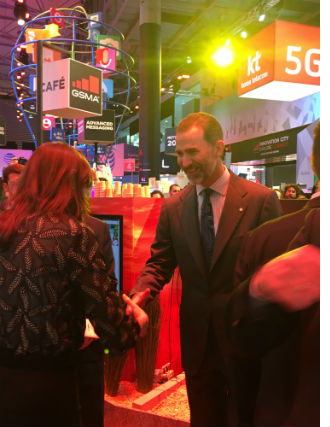Mobile technologies are increasingly becoming ubiquitous across the developing world: out of the 4.8 billion mobile subscribers globally, some 3.6 billion are located in low- and middle-income countries. More specifically, GSM mobile networks are rapidly outpacing the growth of other essential services, expanding at a rate of approximately 11% per year in rural locations. In many ways, mobile has been transformational in extending the reach of life-enhancing services to rural contexts.
To showcase different ways in which mobile is solving everyday challenges in the lives of farmers and rural communities, the Mobile for Development team (M4D) created the interactive Rural Village at this year’s GSMA Mobile World Congress (MWC). With over 108,000 people attending this year’s edition, delegates visiting the Rural Village had the opportunity to experience first-hand a small sample of the different mobile-enabled services that M4D is supporting across agriculture, utilities, mobile money and health and see how these technologies are helping make progress towards the UN Sustainable Development goals.
Set in the heart of the GSMA Innovation City, the Rural Village was designed to lead participants through the daily journey of a villager who uses mobile-enabled services across different aspects of his/her life.
The journey begins by showcasing examples of mobile agricultural solutions that can enhance the productivity and profitability of 500 million smallholder farmers dependent on agriculture for their livelihoods. In a world of increasingly unpredictable weather patterns, farmers need accurate and timely information sources that can help them to cope with a changing climate, reducing risks during the planning, planting, growing and harvesting phases of the production cycle. Ooredoo Myanmar’s Site Pyo smartphone app allows farmers to access daily localised weather forecasts and alerts, agriculture practices guides and market information that help improve their yields and income.
Alongside, managing water pumps in rural sector can be painful and costly task for many farmers in developing countries. Their time and energy is often spent in frequent trips towards distant water pumps to set off the irrigation system for their farmland which can also compromise their safety. Nano Ganesh from Ossian Agro Automation is an electronic device connected to the electrical starter along with a mobile phone that allows farmers to remotely control and monitor water pumps via mobile device.
The next step of the Rural Village journey addresses the villager’s ability to power his or her home or business. While rural contexts often remain disconnected to the main electricity grid, large proportions of then are covered my mobile networks. Pay-as-you-go systems like M-KOPA’s solar home system allow customers to make small incremental payments through mobile money towards owning their own solar home system. This model addresses the key challenges of affordability and payment collection, and connects customers in off-grid households with solar-powered lights, phone charging, radio and TV.
A similar model was showcased by Kopagas’s PAYG LPG service, which allows customers to feed their families through access to safe and affordable cooking gas. Customers to pre-pay for a small amount of cooking gas using mobile money, reducing the large upfront costs of a gas canisters and replacing the unsafe use of charcoal. Smart-metering technology allows the Kopagas system to rapidly identify and address maintenance issues, and monitor customer behaviour.
Mobile also enables users to gain access to essential information on health and nutrition, allowing them to feed their families and look after their health. Visitors of the Rural Village could dial in and listen to HNI’s 3-2-1 mobile service, through which rural households receive nutritional recipes and maternal health tips in their local languages, helping to improve family wellbeing.
Underlying several of these services, the GSMA’s Mobile Money showcased the development of a harmonised industry API that will enable service providers to connect to mobile money platforms in emerging markets, and enable a move towards a plug-and-play environment in the industry over the current bespoke integrations of today. The Mobile Money team exhibited several sample use-cases in which their APIs are providing technology integration, including agriculture, utilities and digital commerce that can be supported by a common API across the industry.
Uniquely different from the other demos exhibited at the Innovation City, the Rural Village attracted many interested visitors and curious onlookers including His Majesty King Felipe VI of Spain.


